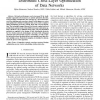Free Online Productivity Tools
i2Speak
i2Symbol
i2OCR
iTex2Img
iWeb2Print
iWeb2Shot
i2Type
iPdf2Split
iPdf2Merge
i2Bopomofo
i2Arabic
i2Style
i2Image
i2PDF
iLatex2Rtf
Sci2ools
JSAC
2006
2006
Mathematical Decomposition Techniques for Distributed Cross-Layer Optimization of Data Networks
Abstract--Network performance can be increased if the traditionally separated network layers are jointly optimized. Recently, network utility maximization has emerged as a powerful framework for studying such cross-layer issues. In this paper, we review and explain three distinct techniques that can be used to engineer utility-maximizing protocols: primal, dual, and cross decomposition. The techniques suggest layered, but loosely coupled, network architectures and protocols where different resource allocation updates should be run at different time-scales. The decomposition methods are applied to the design of fully distributed protocols for two wireless network technologies: networks with orthogonal channels and network-wide resource constraints, as well as wireless networks where the physical layer uses spatial-reuse time-division multiple access. Numerical examples are included to demonstrate the power of the approach.
Related Content
| Added | 13 Dec 2010 |
| Updated | 13 Dec 2010 |
| Type | Journal |
| Year | 2006 |
| Where | JSAC |
| Authors | Björn Johansson, Pablo Soldati, Mikael Johansson |
Comments (0)

